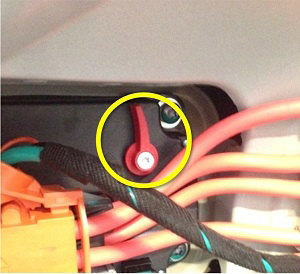Tesla Model S: Charge Port - 3 Phase - Manual Release of Cable
Note: This procedure describes how to manually release a cable from the 3 phase charge port. If the vehicle is equipped with a single phase charge port, refer to procedure 44013005 (refer to procedure).
Warning: Only technicians who have been trained in High Voltage Awareness are permitted to perform this procedure. Proper personal protective equipment (PPE) and insulating HV gloves with a minimum rating of class 00 (500V) must be worn any time a high voltage cable is handled. Refer to Tech Note TN-15-92-003, "High Voltage Awareness Care Points" for additional safety information.
Release Cable
- Perform the vehicle electrical isolation procedure (refer to procedure).
- Remove the LH trunk trim (refer to procedure).
- Press the release lever towards the front of the vehicle and
hold it in place while an assistant removes the charge cable
from the charge port. Once the charge cable is removed, release
the lever.

Reinstall all components that were removed for access.

